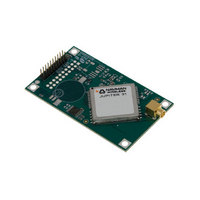AA003041-G Navman Wireless, AA003041-G Datasheet - Page 21

AA003041-G
Manufacturer Part Number
AA003041-G
Description
MODULE JUPITER 31 GPS W/R/A OSX
Manufacturer
Navman Wireless
Specifications of AA003041-G
Frequency
1.575GHz
Sensitivity
-159dBm
Modulation Or Protocol
GPS
Applications
GPS
Data Interface
Connector, 2 x 10 Header, 2 mm Pitch
Antenna Connector
OSX
Voltage - Supply
3.3V
Operating Temperature
-40°C ~ 85°C
Package / Case
Module
Lead Free Status / RoHS Status
Lead free / RoHS Compliant
Features
-
Memory Size
-
Data Rate - Maximum
-
Current - Receiving
-
Other names
943-1007
12.0 Glossary and acronyms
2dRMS: twice distance Root Mean Square
Almanac: A set of orbital parameters that allows calculation of approximate GPS satellite
positions and velocities. The almanac is used by a GPS receiver to determine satellite visibility
and as an aid during acquisition of GPS satellite signals. The almanac is a subset of satellite
ephemeris data and is updated weekly by GPS Control.
C/A code: Coarse Acquisition code
A spread spectrum direct sequence code that is used primarily by commercial GPS receivers to
determine the range to the transmitting GPS satellite.
C/No: Carrier to Noise ratio
A measure of the received carrier strength relative to the strength of the received noise
(measured in dB).
DGPS: Differential GPS
A technique to improve GPS accuracy that uses pseudo-range errors recorded at a known
location to improve the measurements made by other GPS receivers within the same general
geographic area.
GDOP: Geometric Dilution of Precision
A factor used to describe the effect of the satellite geometry on the position and time accuracy
of the GPS receiver solution. The lower the value of the GDOP parameter, the less the error in
the position solution. Related indicators include PDOP, HDOP, TDOP and VDOP.
EGNOS: European Geostationary Navigation Overlay Service
The system of geostationary satellites and ground stations developed in Europe to improve the
position and time calculation performed by the GPS receiver.
Ephemeris: A set of satellite orbital parameters that is used by a GPS receiver to calculate
precise GPS satellite positions and velocities. The ephemeris is used to determine the
navigation solution and is updated frequently to maintain the accuracy of GPS receivers.
GPS: Global Positioning System
A space-based radio positioning system that provides accurate position, velocity, and time data.
OEM: Original Equipment Manufacturer
Re-acquisition: The time taken for a position to be obtained after all satellites have been made
invisible to the receiver.
SBAS: Satellite Based Augmentation System
Any system that uses a network of geostationary satellites and ground stations to improve the
performance of a Global Navigation Satellite System (GNSS). Current examples are EGNOS
and WAAS.
SRAM: Static Random Access Memory
TTFF: Time To First Fix
The actual time required by a GPS receiver to achieve a position solution. This specification
will vary with the operating state of the receiver, the length of time since the last position fix, the
location of the last position fix, and the specific receiver design.
UTC: Universal Time Co-ordinated
The international time standard, a successor to GMT (Greenwich Mean Time).
WAAS: Wide Area Augmentation System
The system of satellites and ground stations developed by the FAA (Federal Aviation
Administration) that provides GPS signal corrections. WAAS satellite coverage is currently only
available in North America.
LA010811B © 2008 Navman Wireless OEM Solutions. All rights reserved. Proprietary information and specifications subject to change without notice.
21















